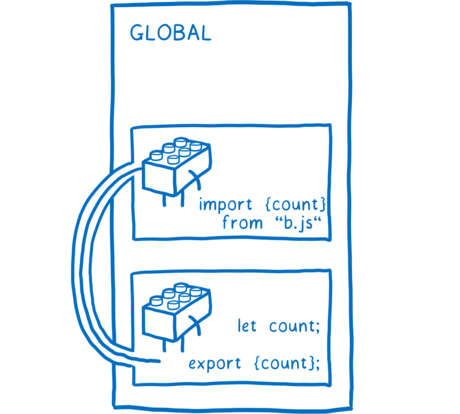Defining and Using Modules
Javascript modules allow us to export and import functions and objects between files.
Table of Contents
- Modules - Some History
- Namespace Collisions
- A Simple Example Collision
- CommonJS and ES Modules
- Export and Import
- Export / Import Example
- Renamed Imports
- Export After Declaration
- Default Exports
- Bundling Modules
- Node Modules
Modules - Some History

During the first twenty years of Javascript development (1995-2015) all of the code added to a web page shared a global namespace.
During this time, third-party libraries and frameworks were most commonly added to a Javascript codebase by manually downloading the library code and loading it through a <script> tag.
Namespace Collisions

A global namespace worked for simple applications but if any included libraries used the same names for global functions, objects, or variables, the names would collide and the code would break.
Web developers came up with work-arounds, like using global objects as namespaces or immediately-invoked function expressions, but these solutions were not ideal.
A Simple Example Collision
Imagine including the following in your index.html document:
<script src="library.js"></script>
<script src="framework.js"></script>
<script src="index.js"></script>
In library.js:
// Saves data to browser's localStorage.
function save(storageData) {
// Implementation details skipped.
}
In framework.js:
// Saves data to server logs using the fetch API.
function save(logData) {
// Implementation details skipped.
}
And then somewhere in index.js:
save("Important Data That Needs Saving!");
Which save() will run? The one from library.js or the one from framework.js?
CommonJS and ES Modules

In 2009 NodeJS added a module system called CommonJS.
Browser code did not support modules until the 2015 addition of ES Modules to the Javascript specification.
🎉🎉🎉
We can now import code into our javascript apps in a safe and standard way!
Resources
- Image Source: ES modules: A cartoon deep-dive
Export and Import
Modules in Javascript are just files.
Files can export functionality which can then be imported by other files.
Two new keywords were added to the language to support this:
export: Marks variables, functions, and objects as accessible from outside the current module.import: Used to import the functionality exported by other modules.
Resources
Export / Import Example
The file colour.js exports a function:
export function randomColour() {
return `#${Math.random().toString(16).slice(2, 8).padEnd(6, "0")}`;
}
The file index.js can now import and use the randomColour function:
import { randomColour } from "./colour.js";
console.log(randomColour());
Renamed Imports
To avoid name collisions we can change the name of imports:
import { randomColour as randHex } from "./colour.js";
console.log(randHex());
Export After Declaration
The export statement can also be used after the declaration.
Knowing this, our colour.js file could also be written:
function randomColour() {
return `#${Math.random().toString(16).slice(2, 8).padEnd(6, '0')}`;
}
export randomColour; // Export by name.
Default Exports
A module might have a single export or it might export a number of functions, objects, or variables.
Single exports can be made default:
// In textHelpers.js:
function reverse(str) {
return [...str].reverse().join("");
}
export default reverse;
// And then in index.js:
import reverse from "./textHelpers.js";
console.log(reverse("Learn to Question"));
**⚠️ Warning: ** No curly braces around the import name when importing defaults.
Bundling Modules

Although all modern browsers support modules, it isn’t yet common practice to rely on browsers to load modules.
Instead, web developers use special programs called “bundlers” to *bundle** all their modules together.
Some common bundlers are webpack, parcel, and rollup.
*Bundle: When used as a verb, bundle means to “tie or roll up a number of things together as though into a parcel.”
Resources
- Can I Use Browser Modules? - Mid-2020: 8% of global web traffic comes from browsers without module support.
Node Modules
An added benefit of bundling is the ability to easily integrate open source libraries.
Libraries are installed from the command line using the npm CLI.
The libraries you install with npm are tracked in the package.json and package-lock.json files, with their source code placed in a node_modules folder.
Resources
To get a sense of the size of the Javascript open-source ecosystem enabled by npm:
- Awesome Javascript - A collection of awesome browser-side JavaScript libraries, resources and shiny things.
“Awesome Lists” like 👆 exist for all sorts of topics and technolgies:
- Here’s an Awesome List of Awesome Lists - Meta-meta!